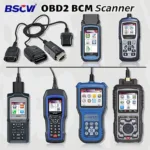Understanding which GM OBD2 pins to use for pulling codes is crucial for effective vehicle diagnostics. Whether you’re a professional mechanic or a DIY enthusiast, knowing how to access your vehicle’s diagnostic trouble codes (DTCs) can save you time and money. This article provides a comprehensive guide to the GM OBD2 pins, their functions, and how to use them to retrieve those crucial diagnostic codes.
Decoding the Mystery: GM OBD2 Pins and Their Functions
The OBD2 connector, a standardized 16-pin port, is the gateway to your vehicle’s diagnostic system. While all OBD2 compliant vehicles share this common interface, some manufacturers, including GM, utilize specific pins for unique communication protocols. Knowing which pins are used for communication, power, and grounding is essential for a successful diagnostic session.
Pin 2: J1850 Bus+
This pin is vital for vehicles using the J1850 PWM (Pulse Width Modulation) communication protocol, common in many older GM models. It carries the diagnostic data stream from the vehicle’s various control modules.
Pin 4: Chassis Ground
Providing a stable grounding point for the scanner, Pin 4 is essential for accurate data transmission. A poor ground can lead to erratic readings or communication errors.
Pin 5: Signal Ground
Similar to Pin 4, Pin 5 provides a signal ground, ensuring a clean and consistent reference point for the diagnostic signals traveling between the scanner and the vehicle’s computer.
Pin 6: CAN High (CAN-H)
For vehicles using the Controller Area Network (CAN) communication protocol, Pin 6 carries the high-speed data stream. This is the dominant communication protocol in most modern GM vehicles.
Pin 7: ISO 9141-2 K-Line
This pin is used for communication on vehicles utilizing the ISO 9141-2 protocol, typically found in some European and Asian models, but also present in certain older GM vehicles.
Pin 10: J1850 Bus-
Working in conjunction with Pin 2 on vehicles using the J1850 PWM protocol, Pin 10 completes the communication circuit.
Pin 14: CAN Low (CAN-L)
Completing the CAN communication circuit with Pin 6, Pin 14 carries the low-speed data stream in CAN-equipped vehicles.
Pin 16: Battery Power
This pin supplies power to the OBD2 scanner directly from the vehicle’s battery, eliminating the need for an external power source.
How to Pull Codes from Your GM Vehicle
Pulling codes from your GM vehicle is a straightforward process. First, locate the OBD2 port, usually found under the dashboard on the driver’s side. Next, plug your OBD2 scanner into the port. Turn the ignition key to the “on” position, but do not start the engine. The scanner will then power up and communicate with your vehicle’s computer. Follow the scanner’s instructions to retrieve the diagnostic trouble codes.
What if My Scanner Doesn’t Communicate?
Sometimes, communication issues can arise. Double-check your connections and ensure the ignition is in the “on” position. If problems persist, check the vehicle’s fuses related to the OBD2 system.
Understanding the Codes: What do they Mean?
Once you’ve pulled the codes, you’ll need to decipher them. Each code corresponds to a specific fault within the vehicle’s systems. You can use online resources, repair manuals, or the OBDFree website to look up the meaning of each code. This information will help you pinpoint the problem area and guide your troubleshooting efforts.
Can I Clear the Codes Myself?
Most OBD2 scanners allow you to clear the codes after addressing the underlying issue. However, simply clearing the codes without fixing the problem will only provide a temporary solution, as the codes will likely reappear if the fault persists.
Conclusion: Mastering GM OBD2 Pin Usage for Effective Diagnostics
Understanding gm obd2 pins to use to pull codes empowers you to take control of your vehicle’s diagnostics. By knowing the function of each pin and the steps involved in retrieving and interpreting diagnostic trouble codes, you can efficiently identify and address potential issues, saving valuable time and money.
FAQ
- What is an OBD2 scanner? An OBD2 scanner is a diagnostic tool used to retrieve trouble codes from a vehicle’s computer.
- Where is the OBD2 port located? It’s typically under the dashboard on the driver’s side.
- What does DTC stand for? DTC stands for Diagnostic Trouble Code.
- Can I damage my car by using an OBD2 scanner? No, using a properly functioning OBD2 scanner will not harm your vehicle.
- What if I can’t find the meaning of a code? Consult online resources, repair manuals, or the OBDFree website.
- Should I clear codes if I don’t know what they mean? No, it’s best to understand the code before clearing it.
- What if the codes reappear after clearing them? This indicates the underlying problem has not been resolved.
For further assistance, contact us via WhatsApp: +1(641)206-8880, Email: [email protected] or visit our office at 789 Elm Street, San Francisco, CA 94102, USA. Our 24/7 customer support team is ready to help.

